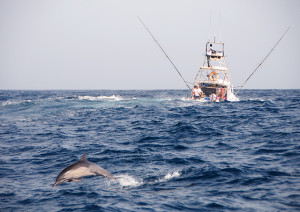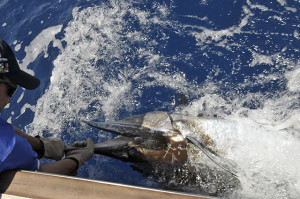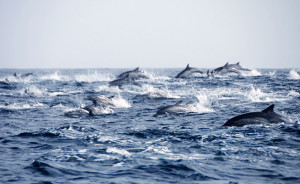Words + Photos By: Antonio Varcasia and Daniele Macis
Issa plays soccer with a ball made of rags on the beach in Dakar with a multitude of young boys. He’s only 12 and his idol is Patrick Viera, hung in a photo faded from the sun in the room he shares with his five brothers. Unlike many of his friends, once adult Issa does not want to be a football player and this is the reason why, almost at sunset, he leaves his noisy “stadium” and go close to shore. He watches the horizon trying to see the typical colourful pirogues of the local fishermen, daydreaming about the possible catches of the day. When he can, he spents a bit of time hearing the tales of his uncle, an old fisherman, which tells him of incredible fish and encounters with real sea monsters that dragged him offshore, desperately attached to a yellow consumed handline whose marks on his skin remain as indelible memory. When he arrived earlier to the beach, Issa has another dream to chase with open eyes, disappearing through a hole in a fence looking for anglers returning from sportfishing in the big boats, which are coming back from the daily pursuit of another myth of his adolescence, the “espadon.” He dreams one day to be there, maybe on a pirogue or also in the tower of a fishing boat, or as mate with big thick leather gloves, ready to tame the giants of the sea. One day he will be there, no doubt, and despite the resistance of his mother, after many entreaties, he obtained the promise from his uncle when he turns 14 years he’ll go fishing with him, to learn from the sea that has always dreamed.
His uncle is usual to tell him how the sea is like a field for farmers: it has its seasons, its time and for taking the big fish you have to wait the right moment, when Alisei winds comes, when the sea changes and is full of life from the surface to the depths.
Between science and tradition: the boreal upwelling
In reality, the wisdom and the popular tradition for centuries, has figured out a unique phenomenon in the Senegalese coast, which is what the Anglo-Saxons called upwelling, or in scientific terms thermohaline circulation. It’s a natural phenomenon due to the global circulation of ocean water masses caused by currents, the upwelling of deep waters along the slope of the continental shelf that pushes offshore the surface waters and it will intensify the biological productivity since it causes the rising mineral nutrients – which together with sunlight – triggers the entire oceanic food chain. This is due to the change in the density of water masses. The density is determined by the temperature (thermo) and salinity (haline) of water. At high latitudes, like in southeast of Greenland and around Iceland, water sinks, and for the low temperature, both for the high salinity caused by the formation of ice. Moving toward the equator the bottom water decreases its density interacting with other waters and tends to rise. In Senegal this phenomenon is due to the current in the Canary Islands, that in the coasts of Mauritania and Senegal creates the boreal upwelling. This phenomenon in Senegal is accentuated by the shape of the continental shelf, rich in submarine canyons. All this means that the waters off the promontory of Cape Verde from June to October are an incredible spot where offshore huge balls of forage fish attract predators of all kinds, from the school of porpoises and dolphins, impressive and spectacular and often followed in the deeper layers of the water from large schools of yellowfin tuna, sailfish and dorado up to the true king of the ocean, the Blue Marlin.
A meeting not to be missed
For this reason, in recent years in the waters in front of Dakar, it is organised by Samir Rahal, avid fisherman and owner of Hotel Terrou-Bi under the patronage of FSPS (Federation of Sport Fishing Senegalese) a Marlin Open tournament now in its fourth edition was held on June 9th to 16th 2012. An event that every year attracts many lovers of marlin fishing from around the world. Every morning at eight o’clock, a huge crowd including anglers, crew mates, officials and hotel staff will give appointment in the hotel marina to begin a challenge that will end only eight hours later. The crew are generally composed of a captain, a fisherman, two mates and a commissioner. After about 20-30 minutes by boat they finally get the best spot for fishing, especially canyons and seamounts, real natural fad for hunting big fish!
The techniques
Fishing in Dakar takes place almost with lures, with which you can cover many miles in order to search for billfish and other pelagics, but also with natural baits, such as bonito and ballyhoo rigged with circle hooks, that are used instead when you can do sight fishing or you can tease a fish very closer to the boat.
If the captain decides to use artificials, usually boats fishing with four rods, two short and two long on outriggers with a classic layout, and usually preceded by teaser driven at a speed between 7 and 8.5 knots depending on the type of lures and fish activity and weather conditions. Artificials are daily checked (along with their 600lbs terminals) and sharpened meticulously, every captain has his personal preferences, even if the Black Bart and Mold Craft often of generous size are the most common employed, and the most popular colours combinations are black and green, black and orange, green and yellow.
Normally, having to be ready to accommodate customers with great or lesser experience, the boats are fully-equipped with fighting chair and normally used rods ranging from 80 to 130 pounds, which also allow anglers with little experience to be able to complete a fight with a big fish without these arriving at the boat exhausted (and anglers too). The average size of the Marlin in Dakar is between 200 and 400lbs, but it is not uncommon to catch big females over 600lbs.
Some captains, depending on the degree of expertise of the angler, are used to opt for a more aggressive strategy, which involves the use of only two or three rods (those long for instance), with lures, while on the short they use only teasers, with two stand-up rods ready with ballyhoo rigged for bait and switch. For those less versed in this world, it is a technique that aims to take the billfish closer to the boat with the teasers’ help, and then allowing the angler to cast his bait on billfish, all at no more than 5-8m from the boat, creating an adrenalinic situation, really hard to describe with words.
Although well known for blue marlin fishing, Dakar is a very interesting spot for fishing other fish, such as sailfish, which peak season is July, but also for the dorado and yellowfin tuna, which together with wahoo are present seasonally. Yellowfins are in the early part of the season in the wake of large schools of dolphins, as in other parts of the world, with sizes between 10 and 80kg, while in October/November is the time for targeting big sized YFT.
Marlin Open
Despite a uncommon atmospheric disturbance which made it more complicated than usual fishing, the marlin open was a great success with a number of participating teams, which led to the capture of several marlin between 250 and 400lbs, plus sailfish, yellowfin tuna (including a beautiful specimen that exceeded 200 pounds), XL wahoo (40-60lbs), and dorados. As planned, the last day, at the return from fishing, the award ceremony took place with a cup, plaques and medals. The same day, a rich buffet offered by the organisation, the competition concluded with the presentation of prizes to the winners.
How to get there
Senegal is quite easy to reach from Europe, with flights from most of European capitals. For your stay we recommend the structure that organises the tournament, Hotel Terrou-Bi (www.terroubi.com), which minimises the distance (10 minutes from the airport) and have a marina few metres from the hotel, from where boats depart for the fishing adventures. The owner, Samir Rahal is an avid fisherman, is always well informed and is the right person to find for asking the right connections with the most reliable boats and captains in the area.
Among the fishing charters mention also for Atlantic Evasion (www.atlantic-evasion.com) by Eric Dubouchet, professional guide who works both in Dakar and in the Bijagos islands, situated off the neighboring Guinea-Bissau.





